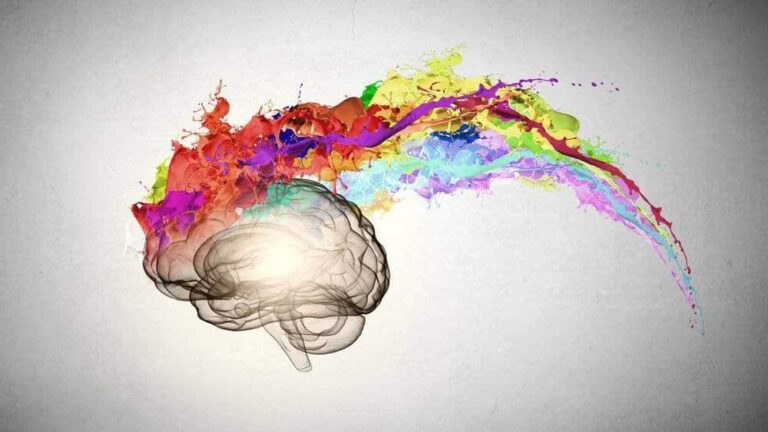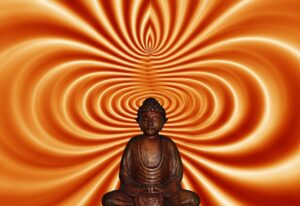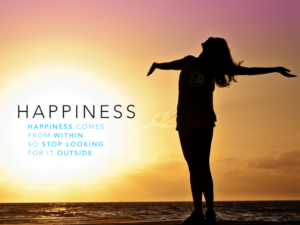Meditation powerfully affects the way in which you experience life. Here’s how…
What is meditation and how does it work?
There are many, many forms of meditation. From tai chi, to raking sand, to sitting and watching the breath, to physical sports… the term “meditation” spans dozens, or even hundreds, of different types of activities. The one thing that all of these activities have in common is their profound effects on the human brain.
We use meditative techniques to develop, and strengthen, our brain’s ability to concentrate. (Before you say “I don’t care about that,” read on to see how increased concentration makes every moment of your life infinitely more powerful).
The “Attention Control Muscles”
Activities that can be described as “meditation” or “meditative activities” train the brain to modulate its attention. The most effective forms of meditation train the brain to be able to:
- consciously notice where its attention is focused at any given moment
- consciously choose an object on which to focus its attention
- hold its attention on one object for an extended period of time
- notice, but not be distracted by, other phenomena while maintaining full attention on one object
These four fundamental faculties of the brain’s “Attention Control Center” are the power-tools that evolution (or God, if you prefer) has given you to consciously control your thoughts, emotions, behavior, and overall experience of life.
One thing that I want you to understand about these four tools is that they become more powerful every time you use them. In this way, they are similar to muscles; they get stronger when you exercise them. For this reason I have decided to call these faculties the “Attention-Control Muscles” all throughout this website; I want you to remember that these “muscles” get stronger when you exercise them.
Benefits of Developing The Attention Control Muscles
So, what’s the point of developing your brain’s ability to concentrate?
Aside from its obvious benefits for people with ADD/ADHD (and those who are merely “scatterbrained”), your brain’s ability to concentrate has extremely powerful effects that permeate every area of your life.
Before we get into details, I want you to understand what “concentration” really means.
The word “concentration” isn’t only used in terms of the mind. We also use it when we talk about liquids.
If you mix a little bit of orange juice into a big glass of water, the juice will be very un-concentrated; in other words it will taste weak, diluted, and “watered down.” If, however, you pour orange juice into a glass with little or no water in it, the taste will be much richer, much stronger… much orange-juicier.
When your attention, your awareness, your consciousness, is “un-concentrated,” your experience of life is “watered down.” When you allow your consciousness to become “concentrated,” it gathers strength, and your experience of life becomes much richer, much deeper… much life-ier.
When your mind is concentrated, everything is just better. Love is warmer, sex is hotter, food is tastier, water is quenchier, colors are brighter, music is richer, skydiving is awesomer, work is workier, productivity is productivitier, etc.
When I use the word “concentration,” this is exactly what I mean. Your “attention” — your “psychic energy” (as Carl Jung liked to call it) — your “life force” is powerfully concentrated in one spot. This is what the ancient Indians (and modern Buddhists) called “Samadhi” (roughly translated as “concentration”).
Development of Samadhi
Meditation is the formal exercise in which we develop samadhi, or concentration. It strengthens our attention-control muscles by giving them the difficult task of focusing on something extremely boring.
This is similar to the way we lift weights in the gym to strengthen our physical muscles; we challenge them to do something that is more difficult than what they are used to doing. Through this challenge, they grow.
We may feel good from endorphins released during the workout, but we notice the real benefits outside of the gym, in our daily lives. We can lift things easier, walk farther, jump higher, run faster. Everything is just smoother. Life becomes easier as the body becomes more powerful.
You may feel good from dopamine released during meditation, but you’ll notice the real benefits over time, in your daily life.
As our minds become more and more concentrated, everything becomes clearer. Anything that we decide to focus on comes into — what we might describe in computer terms as — higher resolution. We are able to see the details of reality that were previously just a blur. It’s like putting on the right pair of glasses after wearing the wrong prescription for years. You never realized that you couldn’t see… until you could.
This enhanced resolution applies to just about everything; sensations, thoughts, emotions, concepts, people, physical objects, etc. Let’s start with sensations because that’s something that pretty much everyone can relate to: pleasure and pain.
Sensations become clearer, both pleasurable and painful. This might sound like an undesirable increase in sensitivity. Who in their right mind wants to experience pain more clearly? On the contrary, however, when you are able to clearly see the nature of the sensations of pleasure and pain, you begin to develop what’s called “equanimity.” You accept reality, seeing it clearly without being disturbed by it. With a more concentrated mind, you will see your painful sensations more clearly, and accept them for what they truly are — simply: sensations.
With this perspective, meditators throughout history have transcended pain to the point of lying on beds of nails, sitting naked in freezing caves, and meditating without eating or sleeping for days on end. When you have mastered pleasure and pain, you move through the world without fear.
Thoughts become clearer as you shift your center of consciousness outside of the whirlwind of your thinking mind. Most people walk through life “surrounded” by thoughts, almost drowning in them. It’s like standing in the middle of a tornado, with its thick grey clouds swirling around you, as you stand in the middle, confused. You can’t see out of the swirling vortex; all you can see are rough outlines, distorted by the clouds.
When you concentrate your mind, you pull together your attentional energy and shift the center of your consciousness to the faculty of perception itself. You step out of the tornado, and into your “Attention Control Center.” From the safety of your Attention Control Center, you look out the big plate glass window.
Now you can see the tornado clearly, like a controlled experiment in the laboratory of your brain. You can see it churning away, picking up objects from the ground of your unconscious mind and throwing them into the air of your conscious experience. You can use the Attention Control buttons at your disposal to zoom in on certain areas of the tornado if you want to, to understand certain thought patterns… or you can just sit back and watch the tornado tire itself out. When the tornado dies down, it puts down all the cows and minivans it picked up. Then you can see everything laid out on the ground, as you look out the window of your Control Room. When everything comes to rest; that’s when you can see your thoughts really clearly.
When you can see your thoughts clearly, instead of getting caught up in them, you can use your thinking process as an extremely powerful tool for understanding.
Emotions become clearer as you learn to separate between your thoughts and your body’s sensations. When you feel pain, for example, it gets swept up in the tornado of your mind, not just as a sensation, but also as a concept. “I feel pain. This is bad.” This creates powerful emotions of “suffering” that sweep through your mind, body, and overall experience.
When you step into your Attention Control Room and watch the tornado die down, you see everything scattered upon the ground. Among the cows and minivans are concepts, ideas, plans for the future, and also your mental reactions to your bodily sensations. When you are able to clearly see which items are important and which items are simply unnecessary, you naturally tend to zone in on the things that are important, and the things that are unnecessary (like emotional suffering) simply don’t bother you anymore. Devoid of your attentional energy, they dissolve back into the Earth from whence they came. The more often you let something go and allow it to dissolve back into the Earth, the more easily it can do so in the future. Your attention is the food of your emotions. When you direct your attention elsewhere, the emotions disappear.
This ability to clearly see your emotions (their relative importance, their desirability, and where they are coming from) gives you extreme power over your inner world. When you are in touch with your emotions, but are never disturbed by them, your inner life becomes deep, rich, and stable.
Concepts become clearer as you develop your mind’s ability to hold its attention on one object for an extended period of time. This particular faculty is important when analyzing an idea, as it allows you to peer deeper and deeper into the depths of understanding. The longer you look, the more detail resolves.
This gives you the ability to understand things very deeply, sort through ideas more efficiently, and learn new things astoundingly easily. Some people say knowledge is power, but I think understanding is far more powerful.
People become clearer when you are able to pour your psychic energy into their souls. In other words, you pour your attention into the subjective world of another human being. You see what life is like for a person, what his world is like, and you begin to connect with people on a much deeper level.
When relating to others, most people experience some level of self-consciousness. We think about ourselves; how we appear to the other person, what to say next, etc. This self-consciousness is a flow of attention toward the self instead of toward the other person in the interaction. This is the opposite of concentration; this is a dilution, a watering-down of attention. Instead of experiencing another person with 100% of your attention, your focus keeps jumping back and forth between yourself and the other. You don’t get a clear picture of the other person, or yourself; only choppy images and a bit of a headache. After a while, it all becomes a blur.
If, however, your Attention Control Muscles are strong, you will tend to hold that person in your attention for the duration of the interaction. Instead of constantly bouncing back to yourself, the flow of attention is steady and uninterrupted. Just as a video camera with a higher frame-rate captures more fluid motion than a camera with a lower frame-rate, you experience this person with as much fluidity as can possibly be perceived by the human brain. Life is constantly moving; when you look at someone in this perspective, you can see the true-life fluidity of his subjective experience. You can see what it’s really like in his world.
When your attention control muscles are strong enough to maintain focus on one person for an extended period of time, it changes the depth of all your relationships. Instead of just noticing people (or even conceptualizing and analyzing them), you truly see them for the first time.
Physical Objects become clearer when you are able to maintain focus on them for an extended period of time. Ancient Buddhist texts liken this type of attention to a “stream of oil, pouring onto an object, without any breaks in the stream.” In normal consciousness, the oil simply drips onto the object. Drip, drip, drip. In concentrated consciousness (samadhi), the oil pours onto the object in a flowing, unbroken stream.
Sometimes, during or after meditation, I am struck by the aspect of physical objects that we call “motion.” The leaves of a tree, swaying in the wind. A duck turning its head, and waddling down a mossy hill. A cloud, drifting across the sky. There is a beautiful kind of fluidity there that I could never notice in a “normal” state of consciousness. Real life motion is not a series of frames like in a movie; it’s a flow, like water flowing in a river. Have you ever seen the difference between a video shot at 15 frames per second and one shot at 400? Play these two videos. Can you see which one has a higher frame rate?
http://youtu.be/jO3dwUKULOE
The top video is shot at a normal frame rate (probably between 15 & 30 fps), while the bottom one was shot at 400. You can see the difference in fluidity, lucidity, clarity. The more fluid video feels more alive than the choppy one.
Real life plays out at an infinite frame rate. The best cameras in the world can capture up to a billion frames per second… yet no camera comes close to capturing the full depth of true, real, fluid motion as it occurs in the physical world around us at every moment of our lives. Think about that for a moment. You can’t even imagine how fluid the world around you actually is.
We see things only as clearly as we are able to. For example, when you bounce a golf ball, does it retain its spherical shape? It sure looks like it does, if your power of concentration is like that of a normal person. But it’s not real. What we are seeing is merely an optical illusion, stemming from our brain’s inability to perceive the ball at each and every moment.
Observe:
In reality, the ball is fluid, just like the water in the sea. We perceive the ball as “solid,” or “spherical” because we only have enough attention to see a limited number of manifestations of reality in any given second.
It’s not our eyes that limit us; light is pouring in like a fluid, unbroken stream of oil. It is our brains’ ability to process that stream of information that determines the depth of our perception of the fluidity of reality.
Through meditation, we increase our powers of concentration and attention. With stronger Attention Control Muscles, we are able to see reality at a much higher frame-rate.
I have been meditating for only four or five years, and I have already noticed this increased fluidity in my perception on many occasions. My own experience of this phenomenon has enabled me to understand many zen koans, and sayings of ancient spiritual masters like Abraham, Jesus, and The Buddha. We’ll get more into depth about this later.
The clarity that we gain in our ability to see the physical world is one of the most powerful effects of meditation. With this increased ability to see the world around us, we can move about with grace, while always being alert to dangerous or opportune changes in our environment. Plus, everything looks super awesome.
Clarity Leads to Richness Leads to Joie De Vivre Leads to Happiness
The more concentrated our minds become, the more clearly we can see everything around us, and inside of ourselves. We can see the way a head-ache throbs and spreads throughout the head. We can see the way the fleeting touch of a potential mate sends shockwaves of electricity through the body. We can see the way the sun makes the surface of the grass sparkle like rippling water as the wind sweeps through the field.
We can see all these things more clearly because our attention flows into them as a steady stream. An un-concentrated mind is scattered amongst many things, constantly jumping from object to object. It doesn’t rest on one thing for long enough to fully appreciate the depth, the texture, the beautiful details of the physically manifested reality of the Universe.
Through meditation-enhanced concentration, we are able to distinguish much richer tones and textures than we had been able to before. This clarification comes as we are more and more able to separate and distinguish between the building blocks of reality.
This heightening and clarifying of your senses gives rise to the “deeper, richer” quality that permeates your life. If you listen to music “in the background” without really concentrating on it, you will probably enjoy it to some degree. If you really concentrate on it, however, you may be able to distinguish between the sounds of each individual instrument. Listening to music in this way makes it feel much more powerful; much richer. It adds texture and depth to your experience of the music. You can dive even deeper into the music by increasing your concentration to the point where you can distinguish between each individual note, each tone, each sound coming out of your headphones and entering your ears. At this level of concentration, time slows down. The world seems to stop; even disappear! You are completely absorbed in the sound. You have entered a world of music.
This is how every experience feels, when you have developed your mind’s capacity for concentration.
The bird’s song is as rich as the music in your Headphone World. The horizon between the sea and the sky is the most beautiful thing you’ve ever seen. Your work is a fun and fulfilling game, and a meaningful contribution to our global civilization. When you are completely absorbed, everything becomes amazing.
When you’re walking around in a world of such rich textures, moving from one profoundly deep experience to the next, life becomes an extremely beautiful adventure.
It is no wonder that this type of “concentrated living” gives rise to a deep sense of well-being, happiness, and joie de vivre.
Quieting the Mind
Now, we’ve talked about how meditation strengthens the Attention Control Muscles and increases the concentration power of the brain.
So, what’s all that stuff we’re always hearing about “quieting the mind?” Isn’t that what meditation is about?
In fact, a quiet mind is a side effect of a concentrated mind.
Contrary to what you are probably seeing in the mass media, most meditation techniques approach the state of samadhi by developing the attention, instead of by trying to eliminate distractions.
We are constantly bombarded with sensory sensations, thoughts, and emotions. These “distractions” will always be around. You can pay for an hour in a sensory-deprivation room, but you can never run away from your thoughts.
With strong Attention Control Muscles, a person can hold one object of focus, and still be aware of the surrounding sensory information streaming in from the outside world (and the brain’s uncontrollable “thinking” process as well). The longer one keeps his attention firmly focused on one object, the more intense the concentration becomes. The outside stimuli are still well within the field of awareness, but they lose their power to distract. We might say that they become “quieter.”
While it is useful, at the beginning of a meditation session, to “quiet your mind,” or “empty your mind,” the main technique is to focus on the object of meditation.
Telling yourself to “stop thinking” is the same as telling yourself “don’t think of a pink elephant.” It’s impossible. The only way you can stop thinking, or not think of a pink elephant, is to turn your attention to something else. If you are pouring 100% of your attention into a aquamarine horse, you cannot think of a pink elephant. If you are pouring 100% of your attention into your breathing process, you can’t help but let the thinking process fade away.
If “inner stillness” and “peace of mind” is what you seek, you will find it through meditation. But if this is the only thing you are seeking, you will never find it. No one can have perfect inner peace, all of the time. The best you can do is exercise your Attention Control Muscles and let them do their thing.
Making Room For Clarity & Insight
In normal, everyday life, we have innumerable thoughts popping up in our heads. Most of these thoughts are repetitive, arising and disappearing over and over and over again.
When you’re under attack by a constant barrage of random thoughts, you can’t really get any “divine inspiration” or deep, existential insights. Your brain recycles the same thoughts over and over again. Everyone has beliefs; when your thought process is running, and you have a “new” thought, you will merely run it through your belief system and either “file it” as support for your beliefs, or discard it, as something that doesn’t fit into your paradigm.
One major advantage of a clear, quiet mind is that it allows room for new insights. In the absence of a “belief structure,” every new bit of information streaming from around you and inside of you can be seen clearly. Reality flows through your consciousness and projects itself into your awareness purely, without being distorted by thoughts and beliefs.
An empty mind is open to reality. A full mind has no room for it.
So, in this way, development of concentration leads to a quiet mind which leads to insights.
“Full Mindedness” versus “Mindfulness”
Some people look down on the idea of “emptying the mind.”
I live in New York, where the Mind is exalted above all else. People here use the expression “empty headed” as an insult, instead of a compliment.
Here in New York, everyone seems to be thinking, all the time. It’s like there’s an unspoken understanding that if you’re not thinking, either you’re stupid, you’re crazy, or you’re wasting time.
Before I started meditating, I couldn’t even conceptualize what it would be like to “not be thinking about anything.” It almost felt scary to think about that kind of thing; like I’d be unconscious, or even cease to exist. When I was fifteen, I asked my cousin from California what she thought about when she was alone. She looked at me with this cheerful expression and said “You know, I don’t really think about anything!” I could not process this, so I concluded that she was demented.
The reason I couldn’t understand what it meant for my cousin to “not really think about anything,” and the reason so many people look down on the idea of “emptying the mind,” is that many people are thinking 24/7, and haven’t stopped in many years. In fact, they don’t know how to stop; they don’t even know that it’s possible! And if it were possible, they certainly wouldn’t want to try it! Completely stop my mind? That seems like a really bad idea. Isn’t that called a coma?
Well, if you’re one of those people, I hope I can clear this up for you.
So what happens when you stop thinking? Do you lose consciousness?
Not at all! In fact, just the opposite thing happens; you gain consciousness of everything that exists outside of your thoughts. All of the mental energy you were directing into your thought process gets freed up, and you can use it for other things (like looking around, running and jumping, or enjoying the taste of your food).
When your brain is filled with thinkin’, you don’t notice the world around you. All you notice is the world of your thoughts. If you’re one of those who has trouble coming out of the thought-world, let me put your mind at ease. I assure you, if you stop thinking right now, nothing bad will happen. In fact, you will probably really enjoy your visit to the “real world,” even if it’s only for a few moments. The real world is very pleasant, and most “normal” people live there. It’s filled with love, and mystery, and fun, and even happiness! Oh, and don’t worry about getting stuck in the “real world;” this is a common fear among compulsive thinkers, but it is completely unfounded. Your brain has formed hard-wired habits through years of 24/7 thinking; if you are even able to stop thinking for five seconds it will be a miracle. It will probably take you years to even get to the point where you can take a five minute vacation from the thought-world.
When you empty your mind of thought, you fill your mind with awareness, receptiveness to sensory information and the world around you, or what we call in Buddhism mindfulness. Instead of following linear trains of thought, you suddenly find yourself surrounded by people, places, and things, in the middle of a big, non-linear situation called “The Present Moment.”
Look up, over the top of your computer screen… you’ll find yourself here, now.
Opening Up To “Now”
Another widely-touted benefit to meditation is that it brings you into “the present moment.”
“The Now” is a wonderful place. It’s always with you, wherever you go. In fact, there is no time that is not now. Check your watch. What time is it? Oh, right, it’s Now.
The past is gone. There’s no reason to live (keep our attention) there, we can’t change it anyway. The future doesn’t exist yet; it’s an imaginary place. Living (keeping our attention) in the future seems useful because it allows us to make plans and control our lives. The problem is that you spend your entire life living in an imaginary place. Except this imaginary place isn’t filled with lollypop trees and unicorn penguins, it’s filled with anxiety, stress, and the cold, colorless world of linear thought.
Between past, present, and future, the only time when you can actually do anything, or experience anything, is in the present. You can’t do anything in the future, because by the time you do it, it’s the present again!
There is a great power that comes with “Living in The Now,” as Eckhart Tolle calls it. You get two major benefits. One is that you will tend to take action more easily when your attention is resting in the here and now. The more important benefit, in my opinion, is that you will actually live your life, instead of completely missing it by living inside the cave of your head the entire time until you die.
The only time you can live is now. The only time you are alive is now. When you realize the importance of this fact, you will realize the true importance of meditation. Don’t let your life pass you by. At least take this moment to appreciate life itself, consciousness, and the beautiful world around you.
I don’t want to get too deep into it in this article, but Eckhart Tolle wrote an amazing book on the subject called “The Power of Now.” I was a depressed nihilist when I picked up the book at a bookstore in NYC; I read one paragraph from the middle of the book, and I was forever a changed man. It’s very, well, powerful. If I had to recommend one book in the entire world, it would be this one. You can order it from Amazon here for around $7… it’ll be the best $7 you ever spend.
Transcending Likes & Dislikes: Developing Acceptance & Equanimity
It is the common habit of most people in this world to “like” certain things, and “dislike” others. We have a powerful instinct, for example, to “like” pleasure, and “dislike” pain. This “liking” and “disliking” causes us to “seek” what we like and “avoid” what we don’t like.
This seems like a perfectly natural thing. In fact, it is perfectly natural, and it goes well with the whole “evolution” thing.
The problem is that this unfortunate habit of “liking” and “disliking” is the fundamental root cause of all of our problems.
In a life filled with liking and disliking, we are constantly bouncing between states of excitement, anxiety, satisfaction, fear, yearning, and anger. We live life on a roller-coaster of emotion and drama.
Worse yet, “liking” and “disliking” lead to “seeking” and “avoiding.” Seeking and avoiding are active behaviors that we compulsively engage in as long as we have “likes” and “dislikes.” We run through our worlds like robots, programmed to seek this and avoid that. This chronic forward-movement has us constantly living in the future, instead of the present moment, the Kingdom of Heaven, the Abode of Reality.
Many people go through their entire lives living in this way. Planning, planning, planning. Running, running, running. The wider the gap between our emotional reaction to our “likes” and our “dislikes,” the more difficult it is for us to slow down, relax, and enjoy life, right now.
Some people, especially in my neck of the woods, have this very reasonable-sounding notion that “living in the future is a good thing.” They believe that by constantly thinking, constantly planning, constantly looking one-step-ahead, they can “get ahead in life.” Their linear, logical, left-brained way of thinking makes a lot of “sense.” If you make a few million dollars by working really hard in your twenties and thirties, you can retire very comfortably while you’re still relatively young. Hey, sounds good to me! In fact, I used to think this way myself.
Unfortunately, there’s a major flaw in this theory, which has become much clearer with the scientific discoveries of the last couple of decades.
“Neuroplasticity” is the word that scientists use for the brain’s ability to change over time. When we think of the human brain, we normally think of it as a solid mass; but in truth, it is just as liquid as the golf ball in the video you saw earlier in this article. If we could watch a fast-motion video of a person’s brain throughout his life cycle, we would see it rippling, morphing, expanding in certain areas and contracting in others.
Scientists have been studying the brains of violinists for a couple of decades now, and have seen an extraordinary amount of physical growth in the areas responsible for the movement of the fingers. There have also been studies of long-time meditators, who have exhibited massive growth in areas of the brain responsible for love, compassion, and “readiness for action.”
The brain grows like our muscles do. When you use your arms, you strengthen your biceps. When you use your “liking” and “disliking” faculty; when you use your “anxiety” and “stress” faculties, when you use your “forward-thinking” and “planning” faculties, you are strengthening these parts of your brain. You are creating habits that are very very very very very hard to change later in life.
The more you dig yourself into the hole of “sacrificing today for a better tomorrow,” the more natural this habit will become. Suddenly, twenty years have passed. You find yourself getting home from the office at one o’clock in the morning; your spouse and your kids are all asleep. You look in the mirror and notice that you’re already past the “prime years” of your life… they flew by in a blur, as you sacrificed them all for a better future. Well, isn’t this the future? If not now, when, right? Sounds like it’s time for a good old fashioned mid-life crisis.
Alright, so now that you’ve bought yourself a sporty new motorcycle, are you going to drive it around the world like you had always planned? Are you going to enjoy life? Nah, impossible, gotta save for little Timmy’s college fund.
Maybe you’ll be one of the lucky ones and have a complete breakdown, quit your job, and follow your dreams. These lucky ones, unfortunately, end up in a living hell; the prison of their own creation. They have spent decades molding their brains into forward-thinking machines, programmed to plan, stress, and avoid that unproductive feeling of contentment at all costs. At this point, re-shaping the brain to even be able to experience peace, quiet, love, and happiness will take years of intensive meditation.
There are many other major problems caused by “liking” and “disliking,” but for now, suffice it to say that liking and disliking is at the root of all suffering and unhappiness in human beings.
So! How to transcend liking and disliking.
As you develop your power of concentration, all phenomena become clearer for you to see. When you see the sensation of pain, for example, you are able to slip your awareness into the space between the arising of the sensation and the “disliking” that arises afterward. As soon as you become aware of the arising of the painful sensation in your body, you allow your attention to flow into it. You watch the sensation; you notice its quality, how it feels, how it moves, pulses, expands, contracts, changes, etc.
You see it arise, you watch it exist, and you see it fade away.
When your power of concentration and your attention control muscles are strong enough to see this all happening fluidly, all sensations become, simply, a beautiful part of life. If you had no sensations at all, you would be numb and dead. Isn’t it wonderful that we are alive and able to feel such varied sensations as warmth, cold, pressure, tickle, etc? This variety of experience is the very thing that gives life its richness, depth, and color!
In this sense, “acceptance” doesn’t translate to “Yeah, it sucks, but there’s nothing I can do.” Acceptance is more like “Wow, look at that!”
“Equanimity” means that you are equally happy with whatever arises; you remain stable emotionally no matter what life throws your way.
This doesn’t mean that you don’t care about what happens. In fact, the more emotionally stable you are, the more easily you can make objective decisions.
Take, for example, the character of the stoic warrior, the heroic police officer, the dauntless firefighter. These people run into battle, literally walk through fire, in order to save peoples’ lives, protect their loved ones, and do what they know is “right.” This type of person goes into a situation knowing he will encounter pain. He knows that he’s going to get cut, shot, and burned. Yet he does it anyway, not because he doesn’t care about his health, but because he knows he can handle it.
This type of equanimity, which comes with the whole “concentration” thing, gives you almost superhuman powers. Not only does it allow you to enjoy life to the fullest, without suffering from things that you “dislike,” it also gives you the courage and strength to do things that other people would be too afraid to do.
Developing Empathy, Compassion, Kindness, & Love
Meditation is also known for its close relationship with what some people might call the “hippie idealism” of “peace and love, man.”
Why? Why is there a correlation here? What’s the connection between “developing concentration” and “peace, love, compassion, and kindness?”
The answer lies in the very nature of love itself… seeing another living being as he truly is… the brain’s ability to experience empathy.
Empathy is the human ability to become aware of the subjective experience of another living being. This is not about reading minds or knowing thoughts; this is about perceiving basic, fundamental experience.
Every one of us walks through his own world.
The world I wander through is filled with awe, wonder, love, depth, warmth, spirit, emotion, pain, pleasure, anxiety, excitement, meaning, emptiness, satisfaction, sadness, mirth, fun, power, expansiveness, music, laughter, tears… all of these things arise and pass away over time. At any one point in time, I may be experiencing any combination of these things, or others. Sometimes I may be overwhelmed by some of these elements of my reality; if I have just experienced a major “loss,” for example, I may be experiencing an overwhelming level of emotion, anxiety, and sadness. If I am walking alone, deep in a beautiful forest, I may be overwhelmed by awe, wonder, and spirit. This is a simple look into “my world.”
Every one walks through his own world, and no two worlds are exactly the same. For example, many of my friends on Wall Street walk through worlds dominated by money, power, fame, reputation, dominance, pride, shame, stress, anxiety, excitement, mania, depression, struggle, luxury, comfort, exhaustion, anger, hatred, violence, politeness, despair, emptiness, responsibility, willpower, loyalty, betrayal… all arising and passing away, constantly changing on a moment-to-moment, day-to-day basis.
The sad little orphan girl, the frat boy, the famous actress, the family-man, even the cow in the field; every creature walks through his own world.
We humans (among others) are blessed with the ability to use our highly-developed brains to look at another creature and get a general idea of what his world is like. We peer into the soul of another, and essentially “step into his world.” This ability is called “empathy,” and is the single most important foundation for “love,” “compassion,” and “kindness.” Without empathy, love does not exist. How can you love someone that you’ve never even met?
Our ability to see into the world of another creature is directly dependent on our ability to hold our attention on that creature for an extended period of time. When our Attention Control Muscles are weak, most of us have a tendency to allow the attention to jump all over the place. This is especially true when it comes to other people, as the attention tends to incessantly jump between the self and the other. Even when we look at the cow in the field, the attention will often jump from the creature itself to our own concept of “cow.” We might think about what type of cow it is, or who the cow “belongs” to. We might even think about hamburgers. It is a rare person who just looks at the cow and allows his attention to rest on the creature itself for long enough to see into its grassy, farty, peaceful world.
When one person looks at another, he can choose to look at that person in many different ways. He can look at the physical appearance of the person, he can look at the actions of the person, he can look at the concepts expressed by the person, he can look at the thoughts of the person, he can look at the emotions in the face of the person.
When we develop our Attention Control Muscles, we can choose to pour our “psychic energy” into the soul of another. In “normal,” western terms: we can direct our attention into the subjective experience of another (by looking into the eyes, facial expressions, voice tone, etc).
In this way, since meditation strengthens the Attention Control Muscles, meditation also strengthens our ability to experience empathy, and thus leads us to experience true love, compassion, and kindness.
If you’d like to read more about empathy, check out my article on Introverted / Extraverted attention, or my article on Nice vs. Kind, which get into more detail on the subject.
Relaxation, Happiness, Dopamine, & Stimulation
Through meditation, we concentrate the mind, and allow it to become peaceful and quiet. When the thought process quiets down, the mind becomes relaxed, and so do the muscles of the body. This “complete relaxation” is very pleasant and enjoyable. In this state, “happiness” is simply natural; when you feel good all the time, what’s not to be happy about?
Dopamine is a chemical in your brain that allows your brain cells (neurons) to communicate with each other. It’s called a “neurotransmitter,” which means that it transmits information from one neuron to another.
When you have brain activity (either through thinking or being stimulated by other sensory phenomena), electricity surges through your brain. Electrical energy pulses through one neuron, which then releases neurotransmitters like dopamine. The dopamine then touches a few other neurons, which get excited by the dopamine and pulse with electricity, and release their own dopamine. That dopamine hits more and more neurons, and electricity pulses through the brain in a big web of activity.
When you’re thinking, you’re keeping the electrical storm in your brain active. Just like when you have a video running on your iPhone for a few hours, you are using a lot of energy.
Now, here’s the big problem with “thinking too much.” Over the past few decades, our scientists have discovered that when we overload our brains with certain chemicals, we actually become less sensitive to those chemicals.
The most obvious example of this phenomenon is that of the heroin addict. Heroin is a drug in the Opiate family. Your brain actually releases opiate chemicals every day, as a natural part of life. Opiate chemicals are pain-killers.
Now, the brain has a tendency to self-adjust, to keep itself balanced. When you flood your brain with pain-killers, the first thing that happens is that you experience a period of time where you aren’t experiencing any pain. The second thing that happens is that your brain naturally adjusts its opiate-sensitivity to bring your body back to its natural balance of pain and pleasure.
Over time, your brain becomes so insensitive to opiate chemicals that your natural opiates will no longer suffice to regulate the pain in your body. When this happens, you must either keep using the drug forever, or go through a period of extreme extreme extreme pain as you wait for your brain to adjust itself back to normal.
Your brain’s dopamine system works in a similar way. Cocaine spikes your dopamine in the same way that heroin spikes your opiates.
Other things that spike your dopamine level include thinking, sex, and any kind of sensory experience. Cocaine is considered a stimulant because it causes your brain to be stimulated into electrical activity (using dopamine as a medium). Thinking, sex, and sensory experience are stimulants in precisely the same way.
When you stimulate your brain by releasing more and more dopamine, your brain adjusts its sensitivity, to keep you “balanced.” Then, if for some reason you stop releasing so much dopamine (by not snorting cocaine, not thinking so much, etc), you have to go through a period of what we call boredom as your brain adjusts itself back to normal.
Boredom is the opposite of stimulation, just as pain is the opposite of pleasure. When you take heroin to kill the pain, the pain goes away in the short term, but you become more susceptible to it in the long term. When you use compulsive thinking to kill the boredom, the boredom goes away in the short term, but you become more susceptible to it in the long term.
When you meditate, your mind becomes quiet, over time. The crazy electrical storm rages on for a little while; it doesn’t just disappear. Your brain is in the middle of a chemical reaction, and it doesn’t just stop when you sit down and watch your breath. However, when you meditate, you stop feeding your brain with new forms of stimulation. If you stop feeding a fire, it won’t go out right away, but it will die down over time; by controlling the fuel input, you control the fire.
In your normal life, by giving attention to your thoughts, you are stimulating your brain, releasing more dopamine, and fueling the electrical storm. When your attention is on something utterly simple and completely unstimulating, like your inhales and exhales, your brain is cut off from all forms of intense stimulation. Boredom attacks very quickly; it rages into your mind like a crazed warlord and demands that you release more dopamine by thinking about something, doing something, feeling something, looking at something, etc.
Most people are too weak to make it through even five minutes of boredom’s all-out offensive. In this way, boredom can be even more powerful than pain. If a heroin junky only had to go through five minutes of pain to get off the drug, he could probably get through it pretty easily. But a thought junky can’t seem to remain calm for even five minutes while experiencing an intense attack of boredom.
It does take a lot of willpower, but it’s no where near impossible. Everyone can overcome dopamine-addiction through meditation. You cut yourself off for five, ten minutes. You feel extremely bored; you’re craving another fix. You indulge it; you get involved with some really juicy thoughts. Ahhhh, stimulation. But wait! No, no, I can do this. Back to the breathing. Over time, your brain becomes less and less stimulated. Less and less dopamine is flowing. You are very, very bored.
But, luckily for us, the brain recovers its dopamine sensitivity much faster than it recovers its opiate sensitivity. After only a few minutes of non-stimulation, the brain becomes much more sensitive to dopamine again.
When you open your eyes after a few minutes of solid meditation, where you really have been starving your brain of stimulation, a whole new world opens up in front of you.
Your brain is now craving stimulation; anything will do. Now, when you open your eyes and see the green of the grass, the simple sensory stimulus of color will release a small amount of dopamine, which will be hungrily absorbed by your brain. At this point, since you’ve got less dopamine floating around, your brain is extremely sensitive to every stimulus. The green of the grass, the blue of the sky, the chime of the bird, the vibrations of the bass from the subwoofer of your speaker system, the taste of your food — even the fascination you feel toward a deep thought or profound insight — everything gets the intensity turned up.
Through meditation, you learn to regulate your own dopamine levels. When you quiet your mind, you turn up the volume of everything around you. This is not just a metaphor, and it’s not just some conceptual thing. This is how your brain’s dopamine system works.
You may be interested to note that this also answers the question that scientists have been puzzling over for the past couple of decades: Why are extraverts happier than introverts?
“Happiness Researchers” have been studying dozens of factors that may or may not contribute to “happiness.” Two of the factors that are the most highly correlated with happiness (higher than money and physical appearance) are “being extraverted,” and “having a sense of connectedness with the world around you.”
“Extravert Researchers,” at the same time, have been trying to figure out what makes some people introverted and some people extraverted. They have found one really interesting fact; extraverts tend to have lower levels of dopamine in their brains, and higher sensitivity to it.
Introverts are constantly stimulating their brains by indulging in their thoughts (thoughts are essentially waves of dopamine and electricity). Extraverts aren’t doing that. When an extravert opens his eyes, his attention is immediately drawn to everything around him, soaking everything in. His brain craves stimulation, and he gets it from outside.
When we quiet the mind through meditation, we actually increase the brain’s desire to draw its stimulation from the things around us. This connects us with “the real world” of physical matter, and gives us a feeling of connectedness with everything around us.
Once you have experienced the difference between the cold darkness of the thought-world in comparison with the warm light of the outside-world, which we share with the trillions of trillions of living souls all around us… you will never again have to wonder why extraverts are happier than introverts. You will simply live and be happy in the real world, with the rest of us 🙂
Spirituality
Meditation is not a religious activity. It is simply an exercise for the brain. So why is it that so many people who are into meditation get all “spiritual” and “mystical” and stuff?
I mentioned above, up in that section with all the chipmunk videos, that meditation makes everything “clearer.” Through enhanced concentration, we are able to see everything in greater detail, depth, and resolution. This enhanced clarity also applies to the nature of reality itself (see, I told you we’d come back to this!), just as it does to simple objects and phenomena like rocks, trees, and people.
Above, with the chipmunks, we discussed how enhanced concentration allows you to see the extreme fluidity of the Universe. We can see how each moment is actually not separate from the one before and the one after; how it’s all part of a spacial flow that we call “time.” As we bring the world into clearer and clearer focus, as our frame-rate increases and we can see the complete fluidity of everything, we can see with our own eyes that time is an illusion, stemming from our brains’ inability to fully perceive the movement of matter and the constantly morphing change of the Universe.
From this understanding of the timeless eternity of reality, one can see what Abraham, Jesus, and the Buddha saw; the prime cause of all existence, the law that allows for existence to be in the first place, that underlies the creation of the Universe in every moment. This is the “God” that Abraham (and many others throughout history) spoke about, which has been completely misunderstood by their followers to mean some kind of active, anthropomorphic deity with humanoid likes, dislikes, and emotions. People who have never learned to concentrate their minds and truly see the fluid, timeless nature of reality, tend to look at “God” as something that “created” the Universe at some “point in time.” This is the source of the illusion of an active deity; the word “created” itself is bound to the illusion of time. It implies that something happened in the past, and is not continuously happening now. To communicate clearly, I prefer to use the words “The Source gives rise to Reality.”
The most hardcore Meditation Masters talk about how the Universe arises from the fabric of reality, moment by moment. Imagine being able to see the physical world at this resolution!!! You might say that this is impossible. I once thought that these masters spoke metaphorically, or conceptually. Now that I have gotten a taste of what it’s like to see the world in a higher frame-rate, and how the entire Universe liquifies at a higher resolution, I can see that the Masters were speaking literally.
At higher and higher resolution, all physical objects are seen to melt into their context. We can look at a tree and see how it is fundamentally “one” with the Earth. If we look at the trunk, we can even see how there is no space between the tree bark and the air around it. Where the form of the tree exists, it pushes into the air and displaces it. The two forms (the tree, and the body of air surrounding it) are in a state of co-dependent flow, like a fish swimming in the ocean.
The tree bark is actually “one” with the air around it. There is fundamentally no separation, because as you zoom in to higher and higher levels of magnification, there is more and more texture, more and more roughness. There are no smooth outlines. If you look closely at the tree trunk, you will see it’s not smooth. It has grooves and bumps all over it. Even if you take a tiny section that seems to be perfectly flat, and put it under a microscope, it has tiny little hills and valleys on it. The more you zoom in, the more roughness you will encounter, until you get to the level of molecules and atoms. At that point, you’re looking at mostly empty space, and the swirling electricity of electron clouds.
At the highest resolution available to our current scientific understanding, everything is actually ONE. Everything is made out of energy. Physical matter is made out of atoms which are made out of energy. Even light, sound, thoughts, and consciousness are made out of energy. This Universe is just one big ball of swirling energy, vibrating at different frequencies, manifesting in various forms.
This is the stuff of “mysticism” and “spirituality.” This is what the historical mystics, like Abraham, Jesus, and the Buddha were talking about. The Ancient Hebrew Mystics didn’t say “There is one god,” they said “God is one.” By looking at the world in a higher resolution, we can see the oneness of reality. Since everyone else is seeing it too (but are not consciously aware that they are seeing it), the message resounds in the depths of the consciousness of the “normal person.” This is why these mystics gained such a following; they were speaking the truth, from a more concentrated state of consciousness.
We too, are able to concentrate our minds to be able to see at this level of fluidity and resolution. It’s very simple; just train your brain to concentrate its attention in the way that you want it to. As your attention control muscles get stronger, the world takes on a richer, deeper, more vibrant quality than you can even imagine.
The Meditative State
There is no one, single meditative state. Rather, it would be more accurate to say that some minds are “more concentrated,” while some are “less concentrated.” It’s a spectrum; today you may be more “meditative,” tomorrow you may be less so.
“The Meditative State” has come to be seen in the popular culture as a sort of blissed-out trance type state. Different people imagine it in different ways; some envision a state of ascetic struggle against the mind, while others imagine a state of uncaring spaced-out escapism, while still others picture a tripped-out psychedelic hypnosis.
The truth is, the Meditative State is much more “down to earth” than all that. States of concentration tend to be characterized chiefly by the states of “relaxation” and “alertness.” Relaxation in the body, alertness in the mind. This is the subjective experience of the meditator. Recent scientific advancements have also shown objective physiological differences between meditators and non-meditators, ranging from brainwave frequencies to muscle tone.
Shinzen Young, an American zen teacher from California, said it most eloquently in his audio-book, “The Science of Enlightenment:”
Alpha [brain-wave frequency] is associated with being relaxed, but alert. That is the quick-and-dirty definition of a meditative state. If you ever need to explain to somebody real quick, what’s the difference between a meditative state and day to day life, it’s real simple. Everybody knows what it’s like to be alert… drink some coffee and bop around town. You’re real alert. Everybody knows what it’s like to be relaxed… go to sleep. If you imagine a state that contains both; the good part of both, without the bad part of either, that would be a state that is both alert but relaxed at the same time. That is a meditative state. Growth in meditation is a growth in alertness — getting brighter and brighter and brighter — and relaxedness — getting more and more and more tranquil in the mind and body.
If you’re interested in learning more about scientific studies and discoveries in regard to the physiological effects of meditation (as well as a whole bunch of other cool stuff), I would highly recommend you check out Shinzen Young’s audio book, The Science of Enlightenment, available on Amazon in mp3 and CD.
Recommended Forms Of Meditation
There are many, many forms of meditation. From tai chi, to raking sand, to sitting and watching the breath, to physical sports…
The following is a list of a few of the styles of Meditation that I enjoy. Everyone’s different. Different people benefit more from one style or another. I hope that you will try a few of these and continue practicing the ones that suit you best.
- Mindfulness of Breathing – Anapanasati – Buddha’s Original Recipe
- Walking Meditation
- Loving-Kindness Meditation
- Eckhart Tolle style “Presence” Meditation
- Physical Labor Meditation
- Tree Meditation
- Chakra Meditation
- Body Awareness Meditation
- Erotic (Tantric) Meditation
- “Ohm” Meditation
- Witness Gaze Meditation
- 5-Minute Meditation
Congratulations on reading all the way through this article! In case you’re wondering, we’re approaching the 9,300 word mark. I hope you’ve gained some valuable understanding from all these thousands of words, but please remember, meditation is not about words. Meditation is something that you have to practice for yourself in order to strengthen your brain’s Attention Control Muscles, and experience the states of deep concentration. Please try out some of the meditation techniques that I have provided for you on this site.
Thanks for reading, and good luck on your journey through life.















A wonderfull resume of many many books on the subject. I don’t know who Kevin is but I do know he is a brilliant spirit. Thanks for the lessons! PJ
AWESOME explanations of so many things I’ve learned along the way (and may have learned much faster had I found this article sooner.) But I must have needed the slow lesson or it would have happened differently, right?! 😛🤪 Yep, everything happens (right now, ha) for a reason!
… [Trackback]
[…] Read More to that Topic: meditationmag.com/blog/what-is-meditation-and-how-does-it-work/ […]
… [Trackback]
[…] There you will find 59482 additional Information on that Topic: meditationmag.com/blog/what-is-meditation-and-how-does-it-work/ […]
… [Trackback]
[…] Information on that Topic: meditationmag.com/blog/what-is-meditation-and-how-does-it-work/ […]
… [Trackback]
[…] Find More Info here to that Topic: meditationmag.com/blog/what-is-meditation-and-how-does-it-work/ […]
… [Trackback]
[…] Here you can find 39077 more Info on that Topic: meditationmag.com/blog/what-is-meditation-and-how-does-it-work/ […]
… [Trackback]
[…] Find More to that Topic: meditationmag.com/blog/what-is-meditation-and-how-does-it-work/ […]
In the realm of the digital landscape, three distinct websites—PinballMachinesMarket.com, MyDrugBank.com, and MoonChocolatesBar.com—shine as unique destinations catering to diverse passions. PinballMachinesMarket.com offers an extensive collection of curated pinball machines, capturing the essence of arcade gaming, while MyDrugBank.com serves as an essential pharmaceutical resource, empowering users with comprehensive drug information and healthcare insights. Meanwhile, https://moonchocolatesbar.com/ indulges users in a sensory journey through gourmet confections, celebrating artful craftsmanship and cultural influences. These platforms collectively embody the versatility of the online realm, bridging entertainment, health, and indulgence while fostering communities, learning, and meaningful connections among enthusiasts.
In the realm of the digital landscape, three distinct websites—PinballMachinesMarket.com, MyDrugBank.com, and MoonChocolatesBar.com—shine as unique destinations catering to diverse passions. PinballMachinesMarket.com offers an extensive collection of curated pinball machines, capturing the essence of arcade gaming, while MyDrugBank.com serves as an essential pharmaceutical resource, empowering users with comprehensive drug information and healthcare insights. Meanwhile, https://moonchocolatesbar.com/ indulges users in a sensory journey through gourmet confections, celebrating artful craftsmanship and cultural influences. These platforms collectively embody the versatility of the online realm, bridging entertainment, health, and indulgence while fostering communities, learning, and meaningful connections among enthusiasts.
… [Trackback]
[…] Find More here on that Topic: meditationmag.com/blog/what-is-meditation-and-how-does-it-work/ […]
… [Trackback]
[…] Find More Info here on that Topic: meditationmag.com/blog/what-is-meditation-and-how-does-it-work/ […]
… [Trackback]
[…] Here you can find 61613 additional Information on that Topic: meditationmag.com/blog/what-is-meditation-and-how-does-it-work/ […]
… [Trackback]
[…] Read More on that Topic: meditationmag.com/blog/what-is-meditation-and-how-does-it-work/ […]
… [Trackback]
[…] There you will find 87648 additional Information to that Topic: meditationmag.com/blog/what-is-meditation-and-how-does-it-work/ […]
… [Trackback]
[…] Read More here on that Topic: meditationmag.com/blog/what-is-meditation-and-how-does-it-work/ […]
… [Trackback]
[…] Here you can find 49096 more Info to that Topic: meditationmag.com/blog/what-is-meditation-and-how-does-it-work/ […]
… [Trackback]
[…] Here you will find 92657 more Info to that Topic: meditationmag.com/blog/what-is-meditation-and-how-does-it-work/ […]
… [Trackback]
[…] Read More to that Topic: meditationmag.com/blog/what-is-meditation-and-how-does-it-work/ […]
… [Trackback]
[…] There you will find 99269 additional Info on that Topic: meditationmag.com/blog/what-is-meditation-and-how-does-it-work/ […]
… [Trackback]
[…] Here you can find 44783 additional Info to that Topic: meditationmag.com/blog/what-is-meditation-and-how-does-it-work/ […]
… [Trackback]
[…] There you can find 84203 more Info on that Topic: meditationmag.com/blog/what-is-meditation-and-how-does-it-work/ […]
… [Trackback]
[…] Find More here to that Topic: meditationmag.com/blog/what-is-meditation-and-how-does-it-work/ […]
… [Trackback]
[…] Info to that Topic: meditationmag.com/blog/what-is-meditation-and-how-does-it-work/ […]
… [Trackback]
[…] Find More here on that Topic: meditationmag.com/blog/what-is-meditation-and-how-does-it-work/ […]
… [Trackback]
[…] Read More Info here to that Topic: meditationmag.com/blog/what-is-meditation-and-how-does-it-work/ […]
… [Trackback]
[…] Read More Info here on that Topic: meditationmag.com/blog/what-is-meditation-and-how-does-it-work/ […]
… [Trackback]
[…] There you will find 12096 additional Information to that Topic: meditationmag.com/blog/what-is-meditation-and-how-does-it-work/ […]
… [Trackback]
[…] Read More Information here to that Topic: meditationmag.com/blog/what-is-meditation-and-how-does-it-work/ […]
… [Trackback]
[…] Find More on that Topic: meditationmag.com/blog/what-is-meditation-and-how-does-it-work/ […]